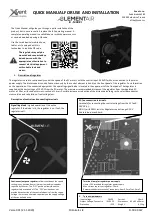
12
UNI 4 Installation Instructions
4 Duct
Connection
4.1 Duct connection in the base
The duct connections for outdoor air can be moved to the
bottom of the unit if desired, by exchanging the ducts and
covers. To loosen the insulation and ducts, do the following
(see Fig. 16):
1. Turn the duct insulation (polystyrene) a quarter turn so
that the marks in the insulation and in the top of the unit
are directly over each other, and then lift up the insula-
tion.
2. Unscrew the fastening screws which sit in the plastic duct.
3. Screw off the plastic duct.
When installing the ducts, follow the same procedure in
reverse order. Install the sealing ends in the bottom of the
ducts which will be used.
4.2 Connecting the unit
•
See Fig. 17.
•
Ensure that the ducts arrive at the right duct - see the
markings on the unit (top and behind the door), as well
as chapter 11.5.
•
Pull the duct insulation well up to the unit.
•
To avoid the formation of condensation, it is particularly
important for the outdoor and exhaust air ducts to have
insulation and a plastic sleeve pulled right down to the
unit. Seal the plastic sleeve to the unit with ties.
•
All ducts that pass through a cold zone must be insu-
lated.
•
The ducts normally require min. 50 mm insulation with
an insulation capacity equivalent to
Ȝ
= 0.035 W/m.°C or
better.
•
The planner is responsible for ensuring that the
necessary correct insulation and steamtight sleeve
are used in relation to the location/temperature
requirements.
•
Lay the outdoor air duct with a slight incline towards the
outdoor air cap so that any water that enters drains out
again.
•
The ducts should be soundproofed properly, especially
above the ventilation unit.
3
The duct insulation is guided
right down to the polystyrene
around the duct. It is very
important that there is no slip
between the duct insulation and
the polystyrene where this may
lead to condensation and/or the
formation of ice.
Pull the duct well over the seal on
the nipple.
The plastic sleeve is
pulled right down to
the unit. Fasten the
sleeve with ties.
1
2
3
Fig. 16
Fig. 17
Indicators













































